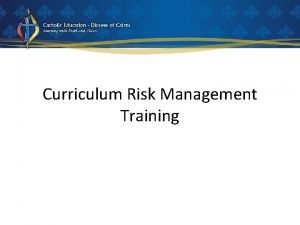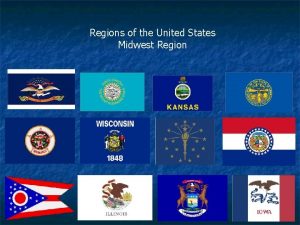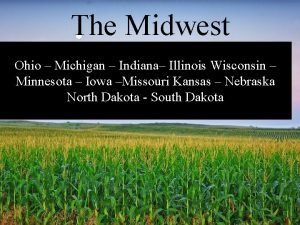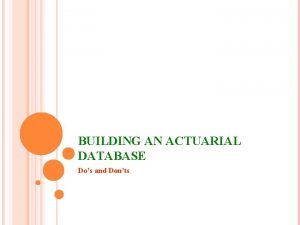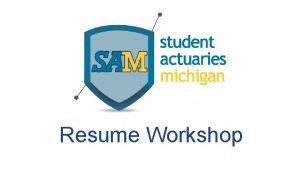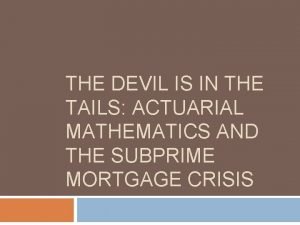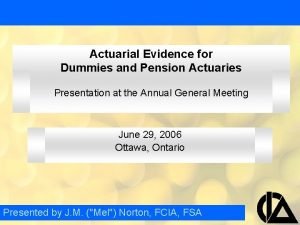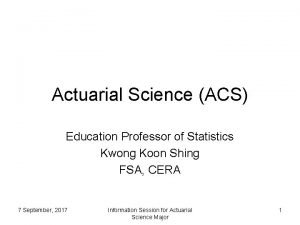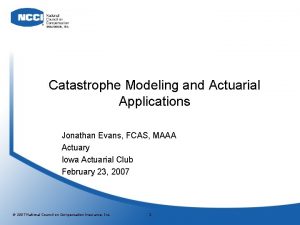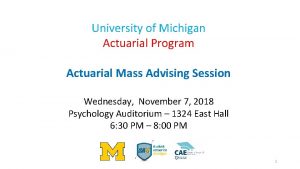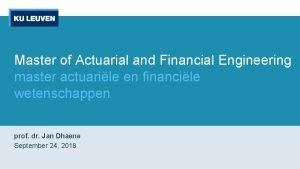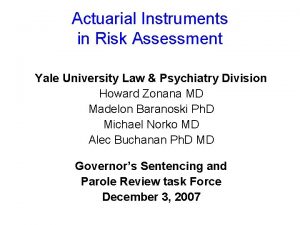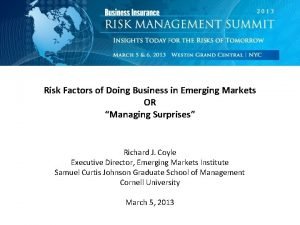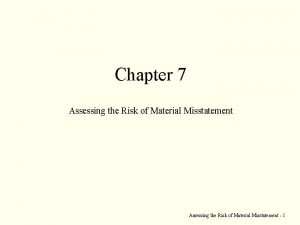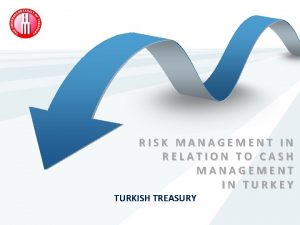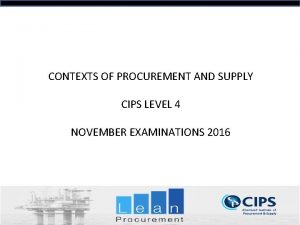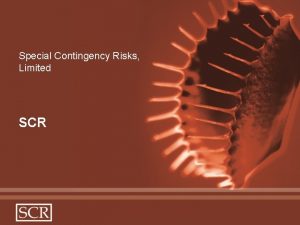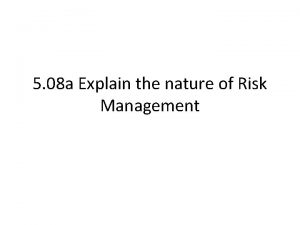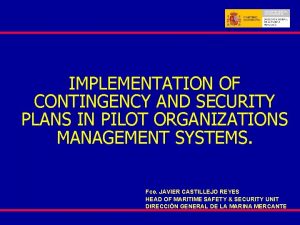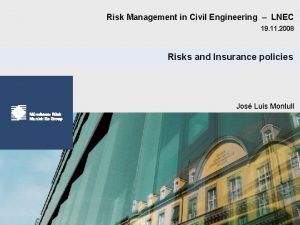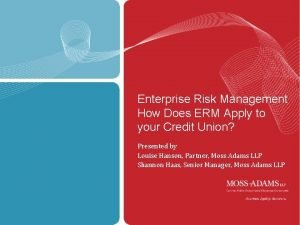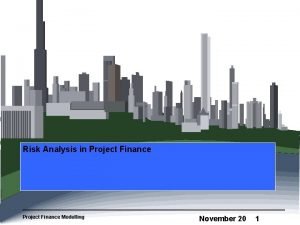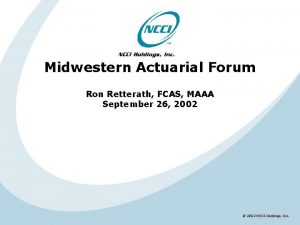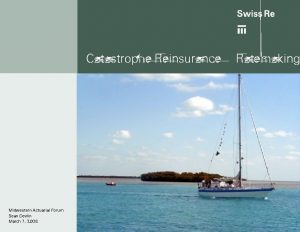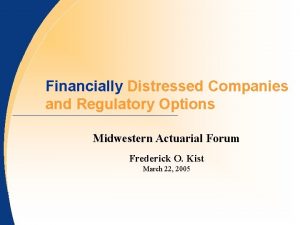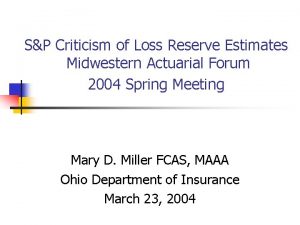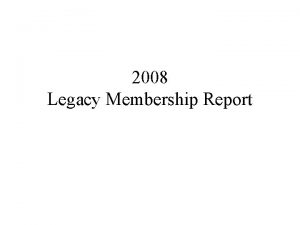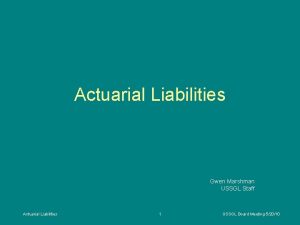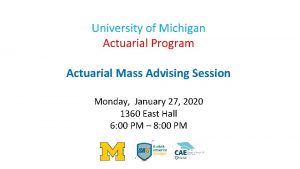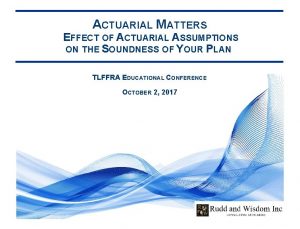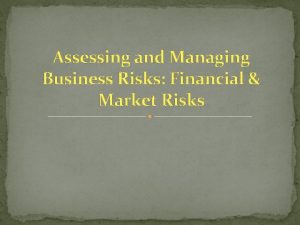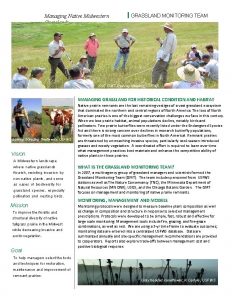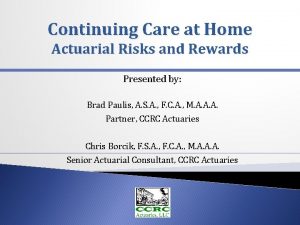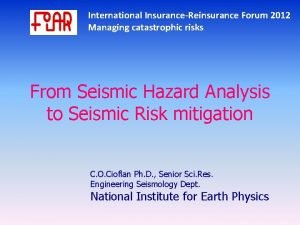Managing Legacy Risks in 2020 Midwestern Actuarial Forum







































- Slides: 39

Managing Legacy Risks in 2020 Midwestern Actuarial Forum Carolyn Fahey AIRROC Rita Zona, ACAS Enstar Group Brian Z. Brown, FCAS Milliman, Inc. October 1, 2020

Audience Polling Question: How do you define runoff? • Business where: § Premiums are no longer being written. § Any discontinued line of business § 1986 and prior § Non-core to the group § All of the above

Runoff Market – What is it? Business that is non-core to the group Any discontinued line of business Companies in runoff want to release trapped capital and achieve early finality Business that is being wound down and no longer underwritten Carriers or business units closed to new business 3

Runoff Market Size $791 bn Estimated Global non-life run-off liabilities Pw. C Global Insurance Run-Off Survey, September 2019. www. pwc. com/globalinsurancerunoffsurvey Developed in conjunction with AIRROC and IRLA 4

Audience Polling Question: Is the run-off market growing? § Yes § Not Sure

Runoff Market in North America runoff market is estimated to be $364 billion in liabilities for non-life insurance, according to the study performed by accounting firm Pw. C referenced previously. § Could be over $1 trillion if life insurance and long-term care included. Includes liabilities from: Insurers Reinsurers Captives Self-Insurers RRGs Etc. 6

AIRROC’s Mission and Vision AIRROC is a non-profit organization of insurance and reinsurance companies that have legacy business in their portfolio. AIRROC has been supporting the industry for 15 years. AIRROC’s Vision is to be the most valued (re)insurance industry educator and network provider for issue resolution and creation of optimal exit strategies. AIRROC’s Mission is to promote and represent the interests of entities with legacy business by improving industry standards and enhancing knowledge and communications within and outside of the (re)insurance industry. Association of Insurance & Reinsurance Run-off Companies (AIRROC), www. airroc. org 7

AIRROC Member Companies AIG, Allianz, Allstate, Aon, Argo Group, Arrowpoint Capital, Armour Risk, Artex, AXA Liabilities Managers, Brandywine Holdings/Chubb, Carrick Holdings, Catalina Re, CNA, Compre, Crawford, DARAG, Dominion Ins. , Enstar, Federated Re, Fleming Re, Lockton Capital Markets, Munich Re, NY Liquidation Bureau, OK Dept. of Insurance, Orion, Premia Re, PRO, QBE, R&Q, Requiem, Resolute Management, Riverstone, ROM, Safety National, Sentry, Sirius, Swiss Re, The Hartford, The Home, Tiger. Risk, Travelers, Willis Towers Watson, Zurich 8

Audience Polling Question: Are the typical run-off deals for large or small amounts? § § § Large In the Middle Small Much Variation in Size Not sure

Runoff Deals Q 2 2020 Pw. C Non-Life Insurance Runoff Deals, Q 2 Update. 10

Sample of Recent Deals – Growth Market Seller / Entity Buyer Date Deal Structure Value Zurich Insurance PLC Maiden Holdings / Maiden Reinsurance North America, Inc. Catalina Holdings Ltd 12/17/2018 Loss Portfolio Transfer $2 billion in gross liabilities Enstar Holdings LLC 12/27/2018 Acquisition of Novation and Retrocession Agreements $272. 4 million Amerisure Mutual Insurance Company Enstar Holdings LLC/ Allianz Risk Transfer Ltd 50% Quota Share Loss Portfolio Transfer $48. 4 million Am. Trust Syndicates Limited Enstar Holdings LLC 2/15/2019 RITC Transactions $830 million of reserves 9/10/2019 Loss Portfolio Transfer $156. 2 million 10/1/2019 Loss Portfolio Transfer $500 million 10/30/2019 Acquisition $800 million in liabilities Munich Re Zurich North America Borg. Warner / Borg. Warner Morse TEC, LLC Enstar Holdings LLC 2019 Catalina Holdings Ltd 12/5/2019 Acquisition Asia Capital Re, which had US $835 million of shareholder equity, US $1. 3 billion of gross liabilities including Unearned Premium Reserve, and total assets of US $2. 1 billion Renaissance. Re Holdings Ltd. / Renaissance. Re (UK) Limited AXA Liabilities Managers 2/4/2020 Acquisition $208 million in gross reserves AXA / AXA XL Enstar Holdings LLC 2/27/2020 Loss Portfolio Transfer Reinsurance $225 million Transaction Aspen Insurance Holdings Limited Enstar Holdings LLC 3/2/2020 Reinsurance Cover - 770 M xs 3. 8 B, 250 M xs 4. 8 B $770 million Lyft Enstar Holdings LLC 3/31/2020 Novation Agreement $465 million Asia Capital Re 11

Audience Polling Question: What business is the largest segment of the run-off sector? § § § | enstargroup. com Accident and Health Asbestos Liability Construction Defect Environmental Liability Professional Liability

Predominant Lines of Business in the Runoff Market Types of claims exposures Mean Asbestos 41. 6% Workers’ Comp 22. 8% Professional lines 12. 6% Accident / health 6. 6% Environmental 4. 0% Product 2. 6% Other latent 1. 9% Construction defect 1. 5% Other 6. 3% From EY/AIRROC(re)insurance runoff survey: In Search of Finality 13

History and Background: Asbestos Background Asbestos: | enstargroup. com • Asbestos was once considered a “miracle mineral” for its effectiveness as insulation and preventing the spread of fires • Late 19 th Century: Production began to skyrocket with commercial mining operations • As early as 1906: Scientific evidence linking asbestos fibers to cancer and other diseases of the lungs • Early 20 th Century: Asbestos production continued to rise, particularly accelerating during World War II • 1970 s: Regulatory agencies (OSHA, EPA) started calling for bans; global production would not peak until 1977 • 1973: Landmark legal decision in Borel v. Fibreboard. Injured workers could sue employers and asbestos manufacturers in a products liability framework rather than through the workers compensation system only • 1980 s: Mounting asbestos losses prompts manufacturer bankruptcies (notably, Johns-Manville in 1982) • 1986: Standard ISO CGL policy form modified to exclude asbestos exposure • Today: Asbestos use has dramatically declined, but significant liability remains from pre-1986 policies. Asbestos now represents the single largest mass tort in US history • Current estimated ultimate loss to the insurance industry: $100 billion 14

History and Background: Environmental Background Environmental: | enstargroup. com • 1980: Comprehensive Environmental Response, Compensation and Liability Act (CERCLA) signed into law, establishing the Superfund program • Goal is to clean up uncontrolled or abandoned hazardous waste sites involving releases of contaminants or other pollution • Superfund permitted the EPA to clean up toxic waste sites and hold responsible parties accountable for the costs • Superfund liability is retroactive, joint & several, and strict; any one party may be held accountable for the entire cleanup of the site if deemed responsible for any portion of the hazardous waste at the site • Defendants typically seek coverage via their CGL policies in place at the time • ISO’s CGL policy language evolved over time; early language intended to exclude pollution was deemed too broad in court, resulting in massive exposure to pollution liability • Current estimated ultimate loss to the insurance industry: $46 billion 15

History of AM Best Ultimates ($ billions) | enstargroup. com Source AM Best data and research. * Estimated, no A. M. Best report available. 16

Industry Paid Losses (A&E) | enstargroup. com 17

Audience Polling Question: Are standard actuarial methods used to measure typical run-off exposures? § § § | enstargroup. com Yes No Not sure

Challenges Inherent with A&E Reserving Traditional actuarial methodologies break down when applied to A&E exposures: Cannot organize data into a loss development triangle Difficulty regarding the loss itself: • Lack of a clearly defined accident date • Reliance upon calendar year paid methods • Inconsistent definitions of case reserves • Lack of cumulative data • Long latency periods between exposure and diagnosis of disease for Asbestos Difficulty determining who pays for losses: • Which policies are triggered? • How does loss get allocated between policies? • How are coverage gaps or overlapping coverages handled? • What happens when coverage detail is missing or vague? Nature of A&E claims produce further challenges: • Bankruptcies among initial defendants leading to suits against other defendants • Insurer insolvencies leading to liability spreading to remaining solvent companies • Vague policy language leading to substantial legal fees that frequently exceed indemnity payments • Class action lawsuits leading to thousands of inactive claims, many of which get dismissed, but still incur legal costs • Alternative explanations for alleged damages (e. g. , smoking) • Claims naming dozens of companies as defendants • Venue shopping for plaintiff-friendly courts Unique challenges in the A&E environment motivate alternative approaches which require the actuary to work closely with claims to gather information needed for reserving. | enstargroup. com 19

What methods are best to estimate run-off exposures? | enstargroup. com

Actuarial Methodologies to Determine Asbestos Reserves Ground-up defendant approach • Individual insureds • Frequency/Severity approach by disease type • Future claim filings • Average settlement rates (trended) • Expense to settlement ratios • Dismissal rates • Allocate to calendar years • Apply coverage chart Aggregate approach • Utilize industry benchmarks • Survival Ratio • Market Share • Development based on AM Best • Requires historical aggregate company and industry data • Footnote 33 • Exclude large payments • Account for commutations • Requires extrapolation • Defendant data not sufficient • Requires IBNR loads | enstargroup. com 21

Ground Up Process for Individual Defendant Claim Parameters • Losses paid to date • Case reserves • Frequencies / severities • Expense ratios • Dismissal rates • Exposure characteristics • Decay curves Coverage Parameters • Insurance policy details (insurer, solvency status, policy dates, participation percentages, policy limits, etc. ) • Allocation framework (all sums, pro rata, etc. ) | enstargroup. com Ground-Up Losses Insurance Allocation • Projected losses for pending claims • Projected losses for IBNR claims • Result: Expected streams of future payments on an undiscounted basis • Allocation of ground-up loss to each available policy in line with coverage parameters and applicable allocation framework • Determination of losses retained by defendant (not covered by insurance) • Expected timing of payments • Ultimate goal: Derive company’s reserves based on exposures 22

Aggregate Process Company Information • Calendar year paid losses • Calendar year incurred losses • Company reserves • Split between Asbestos and Environmental • Not including current exposures Claims and Operations • Reserving strategy (stair stepping) • Treatment of expenses reserves • Settlement strategies • Historical perspective | enstargroup. com Industry Information • AM Best • SNL • Adjust for LPTs Benchmarking of Industry • Survival Ratio: select Industry-wide ratio and apply to company average • Market Share: determine historic ratio of paids or incurreds or reserves to industry, apply to future industry values • Completion methods: Determine factors to bring Industry to ultimate and apply to company inception to date • Ultimate goal: Derive company’s share of the industry reserves 23

Environmental Loss Reserving Environmental losses are often grouped with asbestos losses for financial reporting purposes. The two exposure types have key differences requiring different approaches: Similarities to Asbestos Differences with Asbestos • Complex allocation issues and insolvent insurers resulting in high legal fees • Environmental loss reserving often requires specialized environmental expertise • Bankrupt entities caused damage • Asbestos claims have a much longer latency period: A polluted site is immediately apparent, while an asbestos worker may go 40 years before developing mesothelioma • Overly broad policy language resulting in coverage where coverage was never intended nor priced into rates Actuarial Methodologies to Determine Environmental Reserves Ground-up Approach: • Employ Environmental Expert to evaluate clean up costs for specific sites and allocate costs among responsible parties • Use of decision tree methodology to determine expected or likely outcomes of things such as: • Number of occurrences • Insolvent policies include or excluded • Different damage scenarios • Success of coverage defenses Aggregate Approach: • Similar methodology as for Asbestos | enstargroup. com 24

Audience Polling Question: Allocating legacy clams to policy year is: 1. Simple and straightforward; 2. Somewhat complicated; 3. Extremely complicated.

Insurance Allocation: A Difficult Task The situation gets more complex given the age of relevant policies. Often, grainy photocopies of decades-old documents are all that remain. These complications produce considerable legal expense.

Insurance Allocation: A Difficult Task Insurance coverage detail can get incredibly complex with multiple parties, missing documentation, insolvent insurers, disputed coverages, and other complications. Insurers’ exposure often arises via small portions in various layers of loss across dozens of different accounts. 27

For multiple years of exposure, how are claim costs allocated to year?

Insurance Allocation Simplified – All Sums Allocation Example Total Claims Total Limits Tower 1 Tower 2 Tower 3 Tower 4 Tower 5 $3, 000 $6, 000 Tower Limits Tower Costs $500, 000 $ $1, 000, 000 $ $1, 500, 000 $1, 000, 000 $2, 000 All Sums Allocation is the simplest allocation type to conceptualize and calculate. The insured targets specific year(s) of coverage and damages “spike” up through tower(s). 29

Insurance Allocation Simplified – Pro Rata Pro-Rata Allocation Example Total Claims Total Limits $3, 000 $6, 000 Years Tower 1 Tower 2 Tower 3 Tower 4 Tower 5 1 1 1 Damages/ Year $3 M/5 = $3 M/5 = Tower Damages $600, 000 $600, 000 Pro Rata Allocation is where the allocation is based on damages divided by years of coverage and then allocated up through each tower. Allocating can be fairly simple. Only need to know damages, trigger period, and the policy limits/attachments. The entire coverage chart is not needed. 30

Insurance Allocation Simplified – Bathtub Horizontal Allocation Example Total Claims Total Limits Tower 1 Tower 2 Tower 3 Tower 4 Tower 5 $3, 000 $6, 000 Primary Lims $100, 000 $200, 000 $300, 000 Ex < $500 K $400, 000 $300, 000 $200, 000 Addl Tower Total Tower $ $500, 000 $125, 000 $625, 000 Horizontal allocation is over the entire trigger Period. Typically, primary limits are exhausted before umbrella/excess limits are impacted. Damages are allocated up through the coverage in a straight horizontal line. Like filling a bathtub 31

Insurance Allocation Simplified – Carter-Wallace Allocation Example Total Claims Total Limits Tower 1 Tower 2 Tower 3 Tower 4 Tower 5 $3, 000 $6, 000 Tower Lims/ Tower Total Lims C-W Share Tower Damages $500 K/$6 M 8. 33% $250, 000 $1 M/$6 M 16. 67% $500, 000 $1. 5 M/$6 M 25. 00% $750, 000 $2 M/$6 M 33. 33% $1, 000 Carter-Wallace Allocation distributes damages based on proportion of total limits in each tower. Carter-Wallace share of damages are then allocated vertically up through each tower. 32

Allocation of Loss to Policy: Without Insolvencies After deriving ultimate claims, loss must be allocated to policy. Different allocation methods can produce dramatically different indications per policy. The appropriate allocation method is a matter of legal interpretation and detailed scrutiny of policy language. Need to interact with claims to understand which law applies. 33

Allocation of Loss to Policy: With Insolvencies complicate the allocation. Losses are allocated to policies in the same manner as before, however, coverage holes appear where losses are allocated to insolvent insurers. Coverage gaps can be spread to remaining solvent insurers or back to the defendant to retain without coverage. Additionally, currently insolvent insurers may have partially paid loss before insolvency. The examples shown here allocate currently paid loss to all insurers, but future unpaid loss to solvent insurers only. Need to interact with claims to know about insolvencies. 34

Why do some companies want to sell/exit their run-off exposures?

Seller Motivation § Reduce required capital § Limit risk of adverse development § May help rating § Management can concentrate on core on-going business § Significant legal costs § Staffing issues § Can reduce credit risk associated with reinsurance 36

What factors do reinsurance companies consider when deciding to enter into a particular deal?

Buyer Motivation § Generate a profit – long payout – can invest assets § Economies of scale § Claim settlement opportunities § Reduce legal spend § Build expertise 38

Questions? Carolyn Fahey AIRROC carolyn@airroc. org Rita Zona, ACAS Enstar Group Rita. Zona@enstargroup. com Brian Z. Brown, FCAS Milliman, Inc. brian. brown@milliman. com
 Curriculum activity risk management guidelines
Curriculum activity risk management guidelines Managing risks in schools
Managing risks in schools Midwest region of the united states
Midwest region of the united states Financial aid midwestern state university
Financial aid midwestern state university Midwestern university college of dental medicine
Midwestern university college of dental medicine What is the mid west
What is the mid west Shepherd fungura
Shepherd fungura Actuarial database
Actuarial database Lsa career fair
Lsa career fair Actuarial mathematics
Actuarial mathematics Msc actuarial management
Msc actuarial management Actuarial jokes
Actuarial jokes Southampton actuarial science
Southampton actuarial science Math building purdue
Math building purdue Penn state actuarial science club
Penn state actuarial science club Conrad siegel actuaries
Conrad siegel actuaries Hire purchase in balance sheet
Hire purchase in balance sheet Actuarial evidence
Actuarial evidence Smu actuarial science
Smu actuarial science Catastrophe modeling actuarial
Catastrophe modeling actuarial Student actuaries at michigan
Student actuaries at michigan Febadvisor
Febadvisor Actuarial present value
Actuarial present value Yale actuarial science
Yale actuarial science Risks of doing business in emerging markets
Risks of doing business in emerging markets Lullaby trust spot the risks
Lullaby trust spot the risks Workplace hazards and risks
Workplace hazards and risks Risk of material misstatement table
Risk of material misstatement table Cash management risk assessment
Cash management risk assessment Cips procurement process
Cips procurement process Chapter 20 lesson 2 choosing to live tobacco free
Chapter 20 lesson 2 choosing to live tobacco free Scr limited
Scr limited Possible risks
Possible risks Nature of risk example
Nature of risk example Balfour beatty 6 fatal risks
Balfour beatty 6 fatal risks Credit risk
Credit risk Special contingency risks
Special contingency risks Civil engineering completed risks insurance
Civil engineering completed risks insurance Credit union enterprise risk management
Credit union enterprise risk management Project finance risks and mitigants
Project finance risks and mitigants
